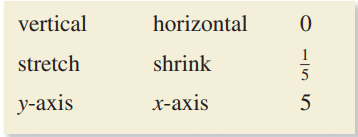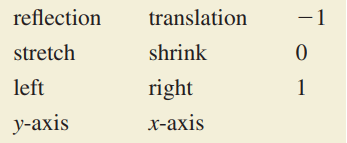WRITE THE LINEAR FUNCTION FOR THE GIVEN TRANSFORMATION OF THE FUNCTION
Subscribe to our ▶️ YouTube channel 🔴 for the latest videos, updates, and tips.
Transformation in terms of g and f.
Let us consider the given functions as g(x) and f(x).
|
Horizontal translation of h units right Horizontal translation of h units left Vertical translation of k units up Vertical translation of k units down |
g(x) = f(x - h) g(x) = f(x + h) g(x) = f(x) + k g(x) = f(x) - k |
Horizontal stretch of a units
Horizontal shrink of a units
g(x) = f(ax)
Vertical stretch of a units
g(x) = f(ax)
Vertical shrink of a units
|
Reflection about x-axis Reflection about y-axis |
g(x) = -f(x) g(x) = f(-x) |
Write a function g in terms of f so that the statement is true.
Problem 1 :
The graph of g is a horizontal translation 2 units right of the graph of f.
Solution :
Let g(x) and f(x) will be the given functions.
Transformation done :
Horizontal translation of 2 units right. Since it is horizontal, we have to remember in opposite way. So, the required numerical value we will use -2.
g(x) = f(x - 2)
So, the required function g in terms of f is f(x - 2).
Problem 2 :
The graph of g is a reflection in the y-axis of the graph of f.
Solution :
Transformation done :
Reflection in the y-axis. Since reflection across y-axis, change x as -x.
g(x) = f(-x)
Problem 3 :
The graph of g is a vertical stretch by a factor of 4 of the graph of f.
Solution :
Transformation done :
Vertical stretch by a factor of 4
g(x) = 4 f (x)
Problem 4 :
The graph of g is a horizontal shrink by a factor of 1/5 of the graph of f
Solution :
Transformation done :
Horizontal shrink by a factor of 1/5. Since it is horizontal transformation, we have to use opposite numerical value.
g(x) = f (5x)
Problem 5 :
The graph of h(x) = a ⋅f(bx − c) + d is a transformation of the graph of the linear function f. Select the word or value that makes each statement true.

a) The graph of h is a ______ shrink of the graph of f when a = 1/3 , b = 1, c = 0, and d = 0.
b) The graph of h is a reflection in the ______ of the graph of f when a = 1, b = −1, c = 0, and d = 0.
c) The graph of h is a horizontal stretch of the graph of f by a factor of 5 when a = 1, b = _____, c = 0, and d = 0.
Solution :
a) Here a = 1/3 , b = 1, c = 0, and d = 0. Applying all values in the function h(x), we get
h(x) = (1/3) ⋅ f(1x − 0) + 0
g(x) = (1/3) ⋅ f(x)
The value of a will say the vertical stretch or shrink. Since a lies in between 0 and 1. So, the answer is vertical shrink.
b) when a = 1, b = −1, c = 0, and d = 0.
h(x) = 1 ⋅ f(-x − 0) + 0
h(x) = f(-x)
Since x is changed as -x, it must be reflection across y-axis.
c) h is a horizontal stretch of the graph of f by a factor of 5 when a = 1, b = _____, c = 0, and d = 0
Since it is horizontal transformation, we have to use the numbers in opposite way. The given factor is 5, but we have to use the value of b as 1/5.
Problem 6 :
The graph of g(x) = a ⋅f(x − b) + c is a transformation of the graph of the linear function f. Select the word or value that makes each statement true.

a. The graph of g is a vertical ______ of the graph of f when a = 4, b = 0, and c = 0.
b. The graph of g is a horizontal translation ______ of the graph of f when a = 1, b = 2, and c = 0.
c. The graph of g is a vertical translation 1 unit up of the graph of f when a = 1, b = 0, and c = ____.
Solution :
a) When a = 4, b = 0, and c = 0. Applying all the values in the function g(x), we get
g(x) = a ⋅f(x − b) + c
g(x) = 4 ⋅f(x − 0) + 0
= 4 ⋅f(x)
Here 4 is greater than 1 and vertical transformation. So, we can use the word stretch.
The answer is vertical stretch
b) when a = 1, b = 2, and c = 0.
g(x) = 1 ⋅f(x − 2) + 0
g(x) = f(x − 2)
Horizontal translation of 2 units to the right.
c) a = 1, b = 0, and c = ____.
g(x) = 1 ⋅f(x − 0) + c
Vertical translation of 1 unit, since it is positive 1 we understand that we move up. So, the answer is vertical translation of 1 unit up.
Subscribe to our ▶️ YouTube channel 🔴 for the latest videos, updates, and tips.
Recent Articles
-
Finding Range of Values Inequality Problems
May 21, 24 08:51 PM
Finding Range of Values Inequality Problems -
Solving Two Step Inequality Word Problems
May 21, 24 08:51 AM
Solving Two Step Inequality Word Problems -
Exponential Function Context and Data Modeling
May 20, 24 10:45 PM
Exponential Function Context and Data Modeling